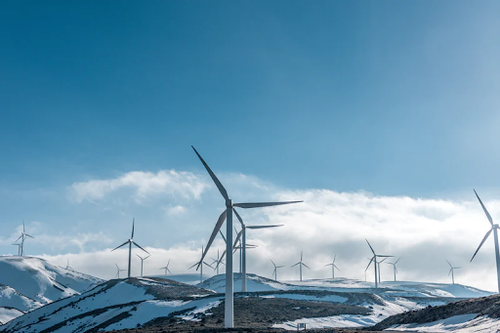
Energy efficiency has gone out of fashion. A quick check of Google trends will confirm this. A 15 year-long steady decline in search volume. But why?

A decade or so ago, energy efficiency was all the rage. Electricity and gas prices were increasing year-on-year and businesses felt the pain. Energy efficiency had a strong business case and was being used as a way to cut costs. The expectation of further price increases strengthened the argument.
At a similar time, Sustainability was doing its own thing. Back then it was all about brand and CSR (Corporate Social Responsibility). Businesses reported on their carbon footprint through various schemes and standards. But few felt the pressure to do anything about it. In many ways, this is still the case.
Viewing energy efficiency as just a cost-cutting exercise is failing to see the bigger picture. It’s not about business cases and ROIs, it’s giving a sh*t about your impact on the planet. It’s giving the world a fighting chance of overcoming climate change.
Where did it all go wrong?
Fast forward to today and as electricity and gas prices have levelled off. The result is that energy efficiency has been lost along the way. Demoted to something businesses feel like they have to do, it rarely gets the attention or the level of investment it needs. Businesses outsource energy efficiency to a consultancy, fail to engage and then complain about the lack of results.
Until we sort the reliability of consumption data, we don’t have a leg to stand on. Poor quality data is the only excuse already sceptical businesses need to kill a project in its tracks. The government’s smart meter rollout was a shambles, but that’s only half of the issue.
Getting hold of a building’s consumption data and maintaining a reliable feed is almost impossible. There is a lack of regulation and major players in data collection aren’t incentivised to do their job well. Without this foundation in place, we’ll continue to go round in circles. If you can’t report on a buildings total energy use you’ll struggle to get investment.
The lack of focus on energy efficiency has stunted the development or energy management software. Outdated systems are still based on the old method of ‘aM&T’ (automatic Monitoring and Targeting). A term coined in the last century.
As businesses become more sceptical of energy efficiency, they will invest less in energy conservation measures. If projects aren’t going ahead, energy management software becomes an unnecessary cost. If software companies can’t increase their user base they’ll fail to win funding to invest in improving their feature set.
We’re creating a self-fulfilling prophecy. Maybe Energy Efficiency is dead? This virtuous cycle won’t end until someone changes the game.
Sustainability rarely leaves the board room
We treat Energy efficiency and sustainability as two different disciplines. The main divide has been the business drivers. Energy efficiency is all about cutting costs, with an internal focus. Sustainability is outward-facing and the main driver is public perception and brand.
In other words, Financial Directors care about Energy Efficiency and Heads of Marketing or Compliance teams care about Sustainability. This is usually reflected in organisational structures and reporting lines.
Sustainability consultants are tasked with meeting requirements of reporting standards and compliance schemes. Started with the best of intentions, these schemes became a box-ticking exercise with little emphasis on making an impact. Time and effort would have been better spent on finding solutions rather than trawling through documentation and avoiding non-conformities.
Sustainability has always had a very top-down nature. You’ll often find senior management roles in Sustainability. The problem is that it very rarely finds its way down to the ‘shop floor’, to the people who actually get the work done. It plays a big part in corporate strategy but hardly ever carries any weight.
This is plain to see in sustainability reporting systems. They sit many levels of abstraction above the detail that’s required to measure anything meaningful. Built upon layers and layers of low-resolution data, they provide the board with the information they need to tick the boxes. Meaning everybody can move on to genuine business issues.
Enter Net Zero Carbon
Over the past few years, everything has changed, or at least it’s starting too. In response to the Paris Agreement, the UK became the first major economy to pass the net zero emissions law. The precedent was set.
Sustainability has always been on the agenda but with the goal of Net Zero Carbon by 2050, we finally have something to aim for. As the first large organisations made the commitment, others felt the pressure and followed suit. Some, like the tech giant Apple, have ambitiously committed to being Net Zero Carbon by 2030. More of this, please.
The commitment came from a sustainability standpoint initially. But as the reality sets in, we’re seeing businesses become aware of what it will take to become truly Net Zero Carbon. There’s no box you can tick or audit you can pass to get the certificate.
For the vast majority of businesses, reducing energy consumption from the grid will play a significant part in their efforts to become Net Zero Carbon. Either by increasing on-site generation through renewables or by reducing the amount of energy needed to operate a building.
Renewable energy is a vital part of the journey towards Net Zero Carbon, but focussing on efficiency will get us there quicker. Time and money should be spent on minimising wasted energy in buildings to reduce the need for as much renewable technology.

The real question is why are we ploughing our resources into developing renewable technologies to generate electricity that didn’t need to be consumed in the first place? We must adopt an efficiency first approach.
My favourite (and overused) metaphor for this is the saying “you can’t out-train a bad diet”. On a fitness program, you tackle your body weight from both sides. You look at the calories consumed through food versus calories expended through exercise. Do the same for your building.
Energy Efficiency in a post-COVID world
The recent pandemic appears to have had a mixed impact on the global perspective towards climate change and sustainability. If nothing else, it’s raised awareness of how we are not that indestructible after all.
Despite the UK government speaking of a ‘green recovery’ from the economic crisis, energy efficiency runs the risk of being overshadowed by an obsession with comfortable and healthy workspaces. I’m not for a second suggesting air quality in densely occupied spaces is not important. But we need to understand the effect it has on energy use.
As buildings reopen, facility managers will be under immense pressure to maintain an acceptable level of air quality. With many influential factors at play, this is a complex task and the stakes couldn’t be higher. The easiest way to achieve this is to bring in as much fresh air from outside as possible and then treat it for temperature and humidity. Great for occupant well-being, devastating for energy efficiency.
Now more than ever, we need a change of mindset. The objective for building managers should be to maintain reasonable levels of lighting, air temperature, humidity, and CO2 concentration whilst using as little energy as possible. There is no ‘reasonable level’ of energy consumption. We need it as low as is feasibly possible.
Repositioning Energy Efficiency
Energy Efficiency isn’t dead, it’s just not positioned correctly. The people who care, don’t understand its value.
When a business launches a new product or service, they first have to create its ‘position’ in the market. This means looking at competitive alternatives, unique attributes, value, target market and current trends.
The problem with viewing Energy Efficiency as a way to cut costs is there are seemingly more tried and tested ways for a business to reduce bottom line costs. There is no unique attribute and therefore, it lacks distinct value. The target market is ‘Finances Teams’ but they just don’t have a good enough reason to care.
Look at Energy Efficiency through the lens of Sustainability and everything changes. There are very few competitive alternatives when it comes to reducing the carbon footprint of a building. So in terms of unique attributes, a cost-effective way to reduce energy in buildings is pretty solid.
When it comes to the target market, reducing carbon emissions is central to the role of Sustainability professionals and energy efficiency is essential to this. Finally, there are few trends that are gaining traction as quickly as Net Zero Carbon and it couldn’t be more relevant.
Let’s reposition Energy Efficiency and put it in space where it can win.
I'd love to hear your opinion on the current state of energy efficiency. You can find me on Linkedin or get in touch by email at jon@fabriq.space

